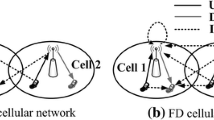Abstract
In the full-duplex wireless cellular system, co-channel interference may limit the achieved cell throughput, and proper radio resource allocation can help to reduce the co-channel interference. In this paper, joint resource allocation on user pairs and resource blocks (RBs) in full-duplex OFDMA cellular system is investigated for benefiting system throughput or user fairness. Firstly, a binary-integer programming optimization problem for maximizing cell throughput is formulated and the optimal solutions are given by exhaustive search. Then, two suboptimal heuristic algorithms are proposed to ease the implementation in practical wireless cellular system. The effectiveness of the proposed algorithms are verified by system level simulations in a full-duplex single cellular system.







Similar content being viewed by others
References
Sahai, A., Patel, G., & Sabharwal, A. (2012). Asynchronous full-duplex wireless. Communication systems and networks. In Proceeding of 2012 fourth international conference on communication systems and networks (COMSNETS), Bangalore, India, January 3–7, 2012, pp. 1–9.
Duarte, M., & Sabharwal, A. (2010). Full-duplex wireless communications using off-the-shelf radios: Feasibility and first results. In Proceedings of 2010 conference record of the forty fourth Asilomar conference on signals, systems and computers, Pacific Grove, California, November 7–10, 2010, pp. 1558–1562.
Everett, E., Duarte, M., Dick, C., et al. (2011). Empowering full-duplex wireless communication by exploiting directional diversity. In Proceedings of 2011 conference record of the forty fifth Asilomar conference on signals, systems and computers, Pacific Grove, California, November 6–9, 2011, pp. 2002–2006.
Ahmed, E., Eltawil, A., & Sabharwal, A. (2012). Simultaneous transmit and sense for cognitive radios using full-duplex: a first study. In Proceeding of antennas and propagation society international symposium (APSURSI), Chicago, Illinois, July 8–14, 2012, pp. 1–2.
Choi, J. I., Jain, M., Srinivasan, K., et al. (2010). Achieving single channel, full duplex wireless communication. In Proceedings of sixteenth annual international conference on mobile computing and networking (ACM MobiCom), Chicago, Illinois, September 20–24, 2010, pp. 1–12.
Li, S., & Murch, R. D. (2011). Full-duplex wireless communication using transmitter output based echo cancellation. In Proceedings of global communications conference (GLOBECOM 2011), Houston, Texas, December 5–9, 2011, pp. 1–5.
Duarte, M., Dick, C., & Sabharwal, A. (2012). Experiment-driven characterization of full-duplex wireless systems. IEEE Transactions on Wireless Communications, 11(12), 4296–4307.
Ahmed, E., Eltawil, A. M., & Sabharwal, A. (2013). Rate gain region and design tradeoffs for full-duplex wireless communications. IEEE Transactions on Wireless Communications, 12(7), 3556–3565.
Vehkapera, M., Girnyk, M. A., Riihonen, T., et al. (2013). On achievable rate regions at large-system limit in full-duplex wireless local access. In Proceedings of 2013 first international black sea conference on communications and networking (BlackSeaCom), Batumi, Georgia, July 3–5, 2013, pp. 7–11.
Bai, J., & Sabharwal, A. (2013). Distributed full-duplex via wireless side-channels: bounds and protocols. IEEE Transactions on Wireless Communications, 12(8), 4162–4173.
Goyal, S., Liu, P., & Panwar, S., et al. (2014). Improving small cell capacity with common-carrier full duplex radios. In Proceedings of IEEE international conference on communications (ICC), Sydney Australia, June 10–14, 2014, pp. 4987–4993.
Shao, S., Liu, D., Deng, K., et al. (2014). Analysis of carrier utilization in full-duplex cellular networks by dividing the co-channel interference region. IEEE Communications Letters, 18(6), 1043–1046.
Everett, E., Sahai, A., & Sabharwal, A. (2013). Passive self-interference suppression for full-duplex infrastructure nodes. IEEE Transactions on Wireless Communications, 13(2), 680–694.
Acknowledgements
This paper was supported by the National Natural Science Foundation of China (Grant No. 61401042 and Grant No. 61561017).
Author information
Authors and Affiliations
Corresponding author
Rights and permissions
About this article
Cite this article
Liu, F., Liu, Z. & Bai, Y. Joint Resource Allocation Algorithms for Full-Duplex Wireless Cellular System. Wireless Pers Commun 96, 1299–1312 (2017). https://doi.org/10.1007/s11277-017-4238-8
Published:
Issue Date:
DOI: https://doi.org/10.1007/s11277-017-4238-8




